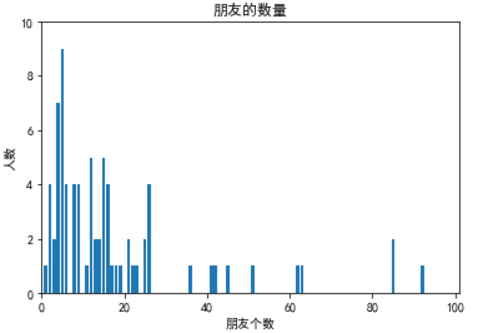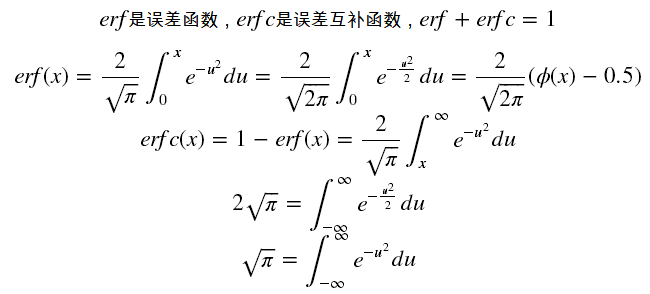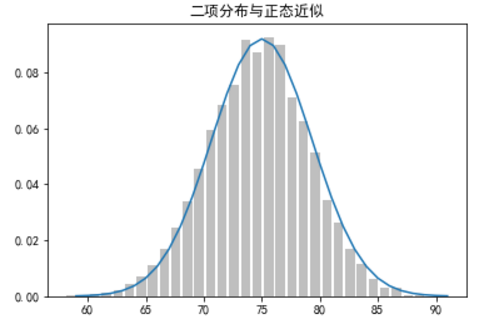Ch4-Ch7 线性代数、统计学、概率、假设与推断
此系列记录《数据科学入门》学习笔记
Ch 4 线性代数
4.1 向量
# 向量加减法
def vector_add(v, m):
return [v_i + w_i for v_i, w_i in zip(v, w)]
def vector_subtract(v, m):
return [v_i - w_i for v_i, w_i in zip(v, w)]
# 一系列向量的加法
def vector_sum(vectors):
result = vectors[0]
for vector in vectors[1:]:
result = vector_add(result, vector)
return result
def vector_sum1(vectors):
return reduce(vector_add, vectors)
vector_sum = patial(reduce, vector_add)
# 标量乘以向量
def scalar_multiply(c, v):
return [c * v_i for v_i in v]
# 计算一系列长度相同的向量的均值
def vector_meam(vectors):
n = len(vectors)
return scalar_multiply(1/n, vector_sum(vectors))
# 两个向量的点乘
def dot(v, w):
return sum(v_i * w_i for v_i, w_i in zip(v, w))
# 计算向量的平方
def sum_of_squares(v):
return dot(v, v)
# 计算向量的长度、距离
import math
def magnitude(v):
return math.sqrt(sum_of_squares(v))
def squared_distance(v, w):
return sum_of_squares(vector_subtract(v, w))
def distance(v, w):
return math.sqrt(squared_distance(v, w))
def distance(v, w):
return magnitude(vector_substract(v, w))4.2 矩阵
# 求维数
def shape(a):
num_rows = len(a)
num_cols = len(a[0]) if a else 0
return num_rows, num_cols
# 返回矩阵的某一行或者某一列
def get_row(a, i):
return a[i]
def get_col(a, j):
return a[:,j]
def get_col(a, j):
return [a_i[j] for a_i in a]
# 根据形状和用来生成元素的函数来创建矩阵
def make_matrix(num_rows, num_cols, entry_fn):
return [[entry_fn(i, j) for j in range(num_cols)] for i in range(num_rows)]
def is_diagonal(i, j):
return 1 if i == j else 0
identify_matrix = make_matrix(5, 5, is_diagonal)
identify_matrix
#[[1, 0, 0, 0, 0],
# [0, 1, 0, 0, 0],
# [0, 0, 1, 0, 0],
# [0, 0, 0, 1, 0],
# [0, 0, 0, 0, 1]]Ch 5 统计学
5.1 描述单个数据集
num_friends = [100, 9, 1, 4, 25, 63, 5, 16, 5, 9, 5, 25, 2, 15, 26, 2, 6, 4, 15, 16, 4, 26, 22, 13, 16, 45,
23, 8, 9, 15, 6, 12, 5, 85, 12, 14, 2, 17, 5, 13, 42, 51, 5, 4, 26, 2, 4, 9, 5, 12, 6, 19,
14, 3, 5, 4, 15, 62, 15, 21, 16, 12, 3, 26, 4, 5, 41, 18, 85, 6, 8, 8, 11, 92, 12, 21, 36, 8]
from collections import Counter
import matplotlib.pyplot as plt
from pylab import *
friend_counts = Counter(num_friends)
xs = range(max(num_friends))
ys = [friend_counts[x] for x in xs]
plt.bar(xs, ys);
plt.axis([0, 101, 0, 10])
mpl.rcParams['font.sans-serif'] = ['SimHei']
plt.title('朋友的数量')
plt.xlabel('朋友个数')
plt.ylabel('人数')
plt.show()
print(len(num_friends)) # 78
print(max(num_friends)) # 100
print(min(num_friends)) # 1
print(sum(num_friends)) # 1441
print(mean(num_friends)) # 18.4743589
print(median(num_friends)) # 12.0
print(sorted(num_friends)[0]) # 1
print(sorted(num_friends)[1]) # 2
print(sorted(num_friends)[-1]) # 100
print(sorted(num_friends)[-2]) # 925.1.1 中心倾向
def mean1(x):
return sum(x) / len(x)
mean1(num_friends) # 18.4743589
def median1(v):
n = len(v)
sortedv = sorted(v)
if n % 2 == 1:
return sortedv[n//2 + 1]
else:
return (sortedv[n//2] + sortedv[n//2+1])*0.5
median1(num_friends) # 12.0
def quantile1(x, p):
p_index = int(p * len(x))
return sorted(x)[p_index]
print(quantile1(num_friends, 0) == min(num_friends)) # True
print(quantile1(num_friends, 0.1)) # 4
print(quantile1(num_friends, 0.99) == max(num_friends)) # Ture
def interquantile_range(x):
return quantile1(x, 0.75) - quantile1(x, 0.25)
interquantile_range(num_friends) # 16
# 众数
def mode1(x):
counts = Counter(x)
max_count = max(counts.values())
return [x_i for x_i, count in counts.items() if count == max_count]
mode1(num_friends) # [5]5.1.2 离散值
def range1(x):
return max(x) - min(x)
range1(num_friends) # 99
def de_mean(x):
x_bar = mean(x)
return [x_i - x_bar for x_i in x]
def variance(x):
n = len(x)
deviantions = de_mean(x)
return sum_of_squares(deviantions) / (n - 1)
variance(num_friends) #450.99284
def standard_deviation(x):
return sqrt(variance(x))
standard_deviation(num_friends) # 21.353985.2 相关
def covariance(x, y):
n = len(x)
return dot(de_mean(x), de_mean(y)) / (n - 1)
covariance(num_friends, randn(len(num_friends))) # -3.47864
def correlation(x, y):
stdev_x = standard_deviation(x)
stdev_y = standard_deviation(y)
if stdev_x > 0 and stdev_y > 0:
return covariance(x, y) / stdev_x / stdev_y
else:
return 0
correlation(num_friends, randn(len(num_friends))) # 0.0512996785.3 辛普森悖论
辛普森悖论是指分析数据时可能会发生的意外。具体而言,如果忽略了混杂变量,相关系数会有误导性。
如果没有这200给数据科学家的受教育程度数据,就会直接得到西海岸的数据科学家天生更有社交能力的结论。
<table>
<tr>
<th width=33.33%, bgcolor = lightblue> 海岸</th>
<th width=33.33%, bgcolor = lightblue> 成员数</th>
<th width=33.33%, bgcolor = lightblue> 平均朋友数</th>
</tr>
<tr>
<td bgcolor=lightgreen> 西海岸 </td>
<td> 101 </td>
<td> 8.2 </td>
</tr>
<tr>
<td bgcolor=lightgreen> 东海岸 </td>
<td> 103 </td>
<td> 6.5 </td>
<tr>
</table>
<table>
<tr>
<th width=25%, bgcolor = lightblue> 海岸</th>
<th width=25%, bgcolor = lightblue> 学位</th>
<th width=25%, bgcolor = lightblue> 成员数</th>
<th width=25%, bgcolor = lightblue> 平均朋友数</th>
</tr>
<tr>
<td bgcolor=lightgrey> 西海岸 </td>
<td> 博士 </td>
<td> 35 </td>
<td> 3.1 </td>
</tr>
<tr>
<td bgcolor=lightgrey> 东海岸 </td>
<td> 博士 </td>
<td> 70 </td>
<td> 3.2 </td>
</tr>
<tr>
<td bgcolor=lightgrey> 西海岸 </td>
<td> 非博士 </td>
<td> 66 </td>
<td> 10.9 </td>
</tr>
<tr>
<td bgcolor=lightgrey> 东海岸 </td>
<td> 非博士 </td>
<td> 33 </td>
<td> 13.4 </td>
<tr>
</table>
6.2 条件概率
import random
def random_kid():
return random.choice(['boy', 'girl'])
both_girls = 0
older_girl = 0
either_girl = 0
random.seed(100)
for _ in range(1000):
younger = random_kid()
older = random_kid()
if older == 'girl':
older_girl += 1
if older == younger == 'girl':
both_girls += 1
if older == 'girl' or younger == 'girl':
either_girl += 1
print('P(both | older) = ', both_girls / older_girl) # 实际值1/2
print('P(both | either) = ', both_girls / either_girl) # 实际值1/3
# P(both | older) = 0.5078740157480315
# P(both | either) = 0.352941176470588266.6 正态分布
import numpy as np
def normal_pdf(x, mu=0, sigma=1):
return (np.exp(-((x - mu) / sigma) ** 2 / 2)/(np.sqrt(2 * np.pi * sigma)))
import matplotlib.pyplot as plt
from pylab import *
xs = [x / 10 for x in range(-50, 50)]
plt.plot(xs, [normal_pdf(x) for x in xs], 'c-', label='mu=0, sigma=1');
plt.plot(xs, [normal_pdf(x, sigma=2) for x in xs], 'm--', label='mu=0, sigma=2');
plt.plot(xs, [normal_pdf(x, sigma=0.5) for x in xs], 'y-.', label='mu=0, sigma=0.5');
plt.plot(xs, [normal_pdf(x, mu=-1) for x in xs], 'k:', label='mu=-1, sigma=1');
mpl.rcParams['font.sans-serif'] = ['SimHei'] # 让汉字正常显示
matplotlib.rcParams['axes.unicode_minus']=False # 让负号正常显示
plt.title('多个正态分布概率密度函数')
plt.legend()
plt.show()
"""标准正态分布的累积分布函数无法用‘基本’的解析形式表示,但是在python中可以用函数math.erf描述"""
import math
def normal_cdf(x, mu=0, sigma=1):
return (1 + math.erf((x - mu) / math.sqrt(2) / sigma)) / 2
xs = [x / 10 for x in range(-50, 50)]
plt.plot(xs, [normal_cdf(x) for x in xs], 'c-', label='mu=0, sigma=1');
plt.plot(xs, [normal_cdf(x, sigma=2) for x in xs], 'm--', label='mu=0, sigma=2');
plt.plot(xs, [normal_cdf(x, sigma=0.5) for x in xs], 'y-.', label='mu=0, sigma=0.5');
plt.plot(xs, [normal_cdf(x, mu=-1) for x in xs], 'k:', label='mu=-1, sigma=1');
plt.title('多个正态分布累积分布函数')
plt.legend(loc=4) # 底部右侧
plt.show()
$$ erf 是误差函数, erfc是误差互补函数,erf + erfc = 1 $$
$$ erf(x) = \frac{2}{\sqrt{\pi}} \int_{0}^{x} e^{-u^2}du = \frac{2}{\sqrt{2\pi}} \int_{0}^{x} e^{-\frac{u^2}{2}}du
= \frac{2}{\sqrt{2\pi}} (\phi(x) - 0.5) $$
$$ erfc(x) = 1 - erf(x) = \frac{2}{\sqrt{\pi}} \int_{x}^{\infty} e^{-u^2}du $$
$$ 2 \sqrt{\pi} = \int_{-\infty}^{\infty} e^{-\frac{u^2}{2}}du $$
$$ \sqrt{\pi} = \int_{-\infty}^{\infty} e^{-u^2}du $$
# 有时候需要对normal_cdf求逆,使用二分法查找
def inverse_normal_cdf(p, mu=0, sigma=1, tolerance=0.00001):
# 如果非标准型,先调整单位使之服从标准型
if mu != 0 or sigma != 1:
return mu + sigma * inverse_normal_cdf(p, tolerance=tolerance)
low_z, low_p = -10, 0 # normal_cdf(-10) -> 0
hi_z, hi_p = 10, 1 # normal_cdf(10) -> 1
while hi_z - low_z > tolerance:
mid_z = (low_z + hi_z) / 2 # midpoint
mid_p = normal_cdf(mid_z) # 考虑cdf在那里的值
if mid_p < p:
# midpoint仍然太低,搜索比他大的值
low_z, low_p = mid_z, mid_p
elif mid_p > p:
# midpoint仍然太高,搜索比他小的值
hi_z, hi_p = mid_z, mid_p
else:
break
return mid_z
inverse_normal_cdf(0.95, mu=0, sigma=1, tolerance=0.00001) # 1.64486.7 中心极限定理
# 等于1的概率是p, 等于零的概率是1-p
import random
def bernouli_trial(p):
return 1 if random.random() < p else 0
def binomial(n, p):
return sum(bernouli_trial(p) for _ in range(n))
# 二项分布的极限是正态,可由图像表示
import matplotlib.pyplot as plt
from collections import Counter
def make_hist(p, n, num_points):
data = [binomial(n, p) for _ in range(num_points)]
# 用条形图绘出实际的二项式样本
histogram = Counter(data)
plt.bar([x - 0.4 for x in histogram.keys()],
[v / num_points for v in histogram.values()],
0.8, color='0.75')
mu = p * n
sigma = math.sqrt(n * p *(1 - p))
# 用线形图绘出正态近似
xs = range(min(data), max(data) + 1)
ys = [normal_cdf(i + 0.5, mu, sigma) - normal_cdf(i - 0.5, mu, sigma) for i in xs]
plt.plot(xs, ys)
plt.title('二项分布与正态近似')
plt.show()
make_hist(0.75, 100, 10000)7.2 案例 :掷硬币
def normal_approximation_to_binomial(n, p):
mu = n * p
sigma = np.sqrt(n * p * (1 - p))
return mu, sigma
# 求某个区间的概率
normal_probability_below = normal_cdf
def normal_probability_above(lo, mu=0, sigma=0):
return 1 - normal_cdf(lo, mu, sigma)
def normal_probability_between(lo, hi, mu=0, sigma=1):
return normal_cdf(hi, mu, sigma) - normal_cdf(lo, mu, sigma)
def normal_probability_outside(lo, hi, mu=0, sigma=1):
# return normal_cdf(lo, mu, sigma) + 1 - normal_cdf(hi, mu, sigma)
return 1 - normal_probability_between(lo, hi, mu, sigma)
def normal_upper_bound(probability, mu=0, sigma=1):
"""return the z for which P(Z <= z) = probability"""
return inverse_normal_cdf(probability, mu, sigma)
def normal_lower_bound(probability, mu=0, sigma=1):
"""return the z for which P(Z >= z) = probability"""
return inverse_normal_cdf(1 - probability, mu, sigma)
# 以均值为中心两端覆盖相同的概率
def normal_two_sided_bounds(probability, mu=0, sigma=1):
"""return the symmetric (about the mean) bounds that contain the specified probability"""
tail_probability = (1 - probability) / 2
# 上界应有在它之上的tail_probability
upper_bound = normal_lower_bound(tail_probability, mu, sigma)
# 下界应有在它之下的tail_probability
lower_bound = normal_upper_bound(tail_probability, mu, sigma)
return lower_bound, upper_bound
mu_0, sigma_0 = normal_approximation_to_binomial(1000, 0.5)
normal_two_sided_bounds(0.95, mu_0, sigma_0)
# (469.01026640487555, 530.9897335951244)
"""势(power)指的是不犯第二类错误的概率"""
lo, hi = normal_two_sided_bounds(0.95, mu_0, sigma_0)
mu_1, sigma_1 = normal_approximation_to_binomial(1000, 0.55)
type_2_probability = normal_probability_between(lo, hi, mu_1, sigma_1)
power = 1- type_2_probability
power # 0.8865
# 左边检验
hi = normal_upper_bound(0.95, mu_0, sigma_0)
type_2_probability = normal_probability_below(hi, mu_1, sigma_1)
power = 1- type_2_probability
print('hi =',hi, 'power =',power)
# hi = 526.0073585242053 power = 0.9363794803307173
def two_sided_p_value(x, mu=0, sigma=1):
if x >= mu:
return 2 * normal_probability_above(x, mu, sigma)
else:
return 2 * normal_probability_below(x, mu, sigma)
# 希望看到的结果有530次正面朝上,用529.5是连续性修正
two_sided_p_value(529.5, mu_0, sigma_0) # 0.0062
extreme_value_count = 0
for _ in range(100000):
num_heads = sum(1 if random.random() > 0.5 else 0 for _ in range(1000))
if num_heads >= 530 or num_heads <= 470:
extreme_value_count += 1
print(extreme_value_count / 100000) # 0.0612
# 单边检验
upper_p_value = normal_probability_above
lower_p_value = normal_probability_below
# 525正面
print(upper_p_value(524.5, mu_0, sigma_0)) # 0.0606
# 527正面
print(upper_p_value(526.5, mu_0, sigma_0)) # 0.04687.3 置信区间
p_hat = 525 / 1000
mu = p_hatsigma = np.sqrt(p_hat * (1 - p_hat) / 1000)
normal_two_sided_bounds(0.95, mu, sigma)
# 因为0.5在区间内,我们无法得到硬币不均匀的结论
# (0.4940490278129096, 0.5559509721870904)
"""1000次抛硬币,540次正面,求估计值0.40的精度,95%置信区间"""
p_hat = 540 / 1000
mu = p_hatsigma = np.sqrt(p_hat * (1 - p_hat) / 1000)
normal_two_sided_bounds(0.95, mu, sigma)
# 因为0.5不在区间内,所以可以得到硬币不均匀的结论
# (0.5091095927295919, 0.5708904072704082)7.5 案例:运行A/B测试
def estimated_parmeters(N, n):
p = n / N
sigma = np.sqrt(p * (1 - p) / N)
return p, sigma
def a_b_test_statistic(N_A, n_A, N_B, n_B):
p_A, sigma_A = estimated_parmeters(N_A, n_A)
p_B, sigma_B = estimated_parmeters(N_B, n_B)
return (p_B - p_A) / np.sqrt(sigma_A ** 2 + sigma_B ** 2) # -1.14034
"""比较两个广告,‘口味好’点击200/1000, ‘营养均衡’点击180/1000"""
z = a_b_test_statistic(1000, 200, 1000, 180)
two_sided_p_value(z) # 0.25414
"""比较两个广告,‘口味好’点击200/1000, ‘营养均衡’点击180/1000"""
z = a_b_test_statistic(1000, 200, 1000, 150)
two_sided_p_value(z) # 0.0031
以上是Ch4-Ch7的相关内容
2018.03.5 YR
